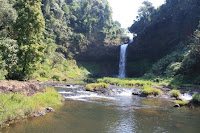 Relaxed Siphandone by boat Khong Island
Relaxed Siphandone by boat Khong Island Full day tour, Meals provided: L (picnic), Tour Code: KLP‐PKZ‐001
Starting from Khong Island at 8.30am, you explore the Siphandone area with your guide on a boat cruise to Khone Island.
Along the way observe locals engaged in fishing, bathing, swimming or farming activities.
On Khone Island visit the remains of a French locomotive. Take then a bicycle and ride to the spectacular Somphamit Falls.
Cycle back to Muang Khone, and enjoy lunch at Seng Ahroun restaurant.
After lunch, ride to the southernmost tip of Khone Island, where you observe the old French
 port, and follow the eastern shore, where concrete embankments used to channel logged trees.
port, and follow the eastern shore, where concrete embankments used to channel logged trees.Cross over the bridge and experience Det Island, the small island to the North of Khone Island. Det Island is a back backer’s paradise. Follow the road to the other end of the railway, where another pier awaits you.
Late this afternoon you return to Khong Island at 4.30pm.
 Discover the Bolaven Plateau: Waterfalls, Gorges,Coffee fields and minorities
Discover the Bolaven Plateau: Waterfalls, Gorges,Coffee fields and minorities Full day tour, Meals provided: L, Tour Code: KLP‐PKZ‐002
You will be met at your hotel around 8.30am for a full day tour of the Bolaven Plateau.
Start your tour by driving up to Paksong, on the way you’ll visit coffee fields, Tad Fane waterfalls and Tad Yeuang ('Wild Goat') waterfall, one of the most spectacular waterfalls in Laos. You make a stop at the local Paksong Market.

Your Lao lunch is served at Ban Ta Thang nearby the market or at Tad Lo Waterfall.
After a short rest, you'll drive to Ban Kok Phoung to meet the Katou, one of the indigenous Mon‐Khmer ethnic groups in this area. Khmu, Alat, Ngae, Kalung, Lavane, Lavere, Katung ethnic groups you can be observed here, too.
You'll then continue your visit to Ban Houay Houn, a traditional weaving village. From here drive to Tad Phasuam and visit a small nearby ethnic cultural park.
Return to your hotel at 4.30pm.
 Explore Wat Phou, Wat Muang Kang and Wat Tomo
Explore Wat Phou, Wat Muang Kang and Wat Tomo Full day tour, Meals provided: L, Tour Code: KLP‐PKZ‐003
Meet at 8am at your hotel; and visit Pakse’ fresh market, where your guide explains you local products. Then drive to Champassak. On the way you visit Wat Phou Ngoy.

Visit Wat Phou. This Khmer temple Wat Phou was declared a World Heritage Site by UNESCO in 2002. The walk to the upper part of the temple is steep, but the view over the surrounding countryside is rewarding.
You have a simple lunch 'fer' at the local noodle soup shop.
 After lunch continue by boat to a nearby temple, Vat Muang Kang. Vat Muang Kang is the oldest temple in Champassak. Its French‐Lao fusion style library (tripitaka) is a unique architectural example of the colonial past.
After lunch continue by boat to a nearby temple, Vat Muang Kang. Vat Muang Kang is the oldest temple in Champassak. Its French‐Lao fusion style library (tripitaka) is a unique architectural example of the colonial past.Continue to visit Um Muang by boat. Um Muang (aka Wat Tomo) is a small Khmer temple ruin in the forest.
Return by car back to Pakse at 4.30pm.













































